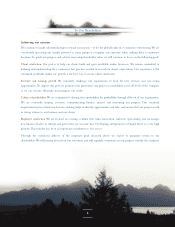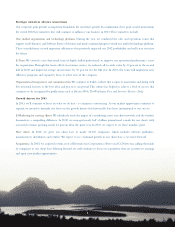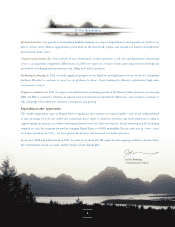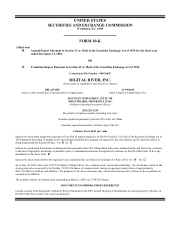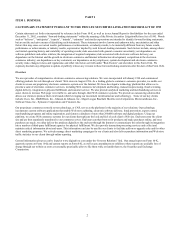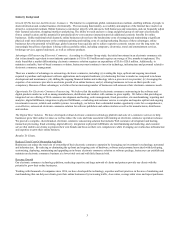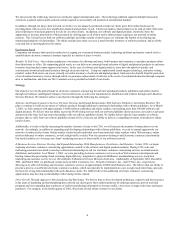Digital River 2002 Annual Report Download - page 14
Download and view the complete annual report
Please find page 14 of the 2002 Digital River annual report below. You can navigate through the pages in the report by either clicking on the pages listed below, or by using the keyword search tool below to find specific information within the annual report.8
Technology
We deliver our electronic commerce outsourcing solution primarily using our CNS. During 2002, we made substantial progress in completing
development of our 100% Java, J2EE-compliant software technology platform. We have started migrating our current clients from CNS version
3 to our CNS version 4 platform, and we intend to continue migrating clients to this new platform throughout 2003. The following is a brief
description of our CNS platform.
Architecture. Our scalable CNS is designed to handle tens of thousands of individual electronic commerce stores and millions of products. The
CNS consists of multiple pods of Sun Microsystems servers and a proprietary software application that serves dynamic Web pages using
Oracle’ s 8i and 9i database and 9iAS application server. Akamai’ s worldwide caching technology enables our platform engine to serve pages
with consistent page loadtimes across the world. Our CNS was designed to scale to support growth by adding additional servers, CPUs, memory
and bandwidth without substantial changes to the application. The CNS software code is written in modular layers, enabling us to quickly adapt
in response to industry changes, including bandwidth opportunities, payment processing changes, international requirements for taxes and
export screening, new technologies such as Web Caches, ML, DHTML, VRML, SET, banking procedures and encryption technologies. The
CNS product search system, based on Verity’ s technology, allows end-users to search for items across millions of potential products and
thousands of categories specific to various product specifications, while maintaining a fast page response that is acceptable to the end-user. We
use sophisticated database indexing coupled with a dynamic cache system to provide flexibility and speed. These caches help increase the
overall speed of each page and facilitate complex searches across our entire inventory of software products. The CNS has also been designed to
index, retrieve and manipulate all transactions that flow through the system, including detailed commerce transaction and end-user interaction
data. This enables us to create proprietary market profiles of each end-user and groups of end-users that can then be used to create
merchandising campaigns. Our CNS is also used for internal purposes, including reporting and maintenance for fraud detection and prevention,
physical shipping, return authorizations, back order processing and full transaction auditing and reporting capabilities for all commerce
functions.
Web Commerce System Maintenance. Our clients’ electronic commerce systems are built and maintained using the CNS centralized
management system and remote control tools. Global changes that affect all electronic commerce systems or groups of electronic commerce
systems can be made as easily as changes to an individual electronic commerce system. Client electronic commerce systems typically include a
main store and may optionally include “channel sites” to which highly targeted traffic may be routed. Clients may also link specific locations on
their Web stores to detailed product or category areas of the stores in order to better target their end-users’ interests.
Security. Our security systems control access to internal systems and commerce data via the Internet. Internally, log-ins and passwords are
maintained for all systems, with additional log-ins, passwords and IP access control granted on an individual basis to only the required
commerce areas for which the recipient is responsible. Firewalls prevent unauthorized access from outside. We rely on certain encryption and
authentication technology licensed from third parties to provide secure transmission of confidential information, such as end-user credit card
numbers. Unix, Oracle and Web server security additionally restrict access from the outside to the appropriate transaction data. The CNS
security system is designed not to interfere with the end-user experience. We believe that clearing-house processing and additional password
mechanisms that negatively impact digital delivery performance are not needed. The CNS security system does not allow direct access to any
client or customer data. It also ensures that all end-user requests for digital delivery of product are through a valid CNS page and that the
customer has purchased the product.
Data Center Operations. Continuous data center operations are crucial to our success. Our primary data center (DC1) is located in our main
facility in Eden Prairie, Minnesota. We also operate a secondary data center (DC2) at a separate location in the Minneapolis area that serves as
a disaster recovery site. Both locations are currently processing transactions and downloads. All transaction data is replicated from DC1 to
DC2 in less than 10 seconds. Our network software constantly monitors clients’ electronic commerce sites and internal system functions and
notifies systems engineers if any unexpected conditions arise. We currently lease three OC3 lines and 2 DS3 lines from multiple vendors and
maintain a policy of adding additional lines if more than 50% of our bandwidth capacity is consistently utilized. Accordingly, if one line fails,
the other lines are able to assume the capacity of the failed line. In the event of electrical power failure, we have three redundant diesel
generators and two redundant UPS power supplies that protect the entire facility. We have also installed a FM-200 automatic fire suppression
system in the data center. The data center currently utilizes multiple levels of redundant systems including load balancers, web servers,
application servers and disk arrays. We currently have automatic failover processes in place in case of equipment or software failure. When a
fault is detected on a server, a process automatically de-configures that node from the production POD and processing continues on the
redundant nodes of the POD.


